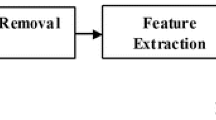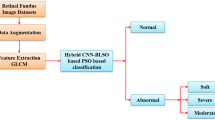Abstract
It is one of the most vital symptoms of DR (diabetic retinopathy) called hard exudates (HE), which are the leakage of cellular debris and lipoprotein from damaged blood vessels of retina. The vision loss is avoided if the detection of HE in the beginning times. Therefore, a novel method is proposed to detect hard exudates automatically. Previously, for exudate prediction supervised and unsupervised methods have been used. Fault detection of hard exudates, miss classification rate will affect these models because of the characteristics like, similarities with other components in the retinal image and intra variations. For that, the retinal fundus images has been used as input. Then these images are pre-processed with some pre-processing algorithms like image enhancement, equalization of histogram to improve the proposed system performance. Total image data files are divided to training and testing datasets. Features are extracted for training and testing using feature extraction algorithm individually. Then classifier algorithm predicts whether the hard exudate is proliferative or non-proliferative. We obtained accuracy of 99.34% using our proposed methods on public datasets like DIARETDB1 and DRIVE.












Similar content being viewed by others
References
Haloi, M., Dandapat, S. and Sinha, R., A Gaussian scale space approach for exudates detection, classification and severity prediction.arXiv preprint arXiv:1505.00737, 2015.
Raj, A.M and Mani, S.A., Retinal Abnormality Risk Prediction Model: A hybrid approach based on vessel characteristics and exudates. Artificial intelligence and evolutionary computations in engineering systems, Springer, New Delhi, 803–818, 2016.
Ajwahir, M. I.S., Rajamani, K, and Sadhar, S.I., A novel technique for splat generation and patch level prediction in diabetic retinopathy. Annual conference on medical image understanding and analysis, Springer, Cham 50–59, 2017.
Marin, D., Gegundez-Arias, M. E., Ponte, B., Alvarez, F., Garrido, J., Ortega, C., Vasallo, M. J., and Bravo, J. M., An exudate detection method for diagnosis risk of diabetic macular edema in retinal images using feature-based and supervised classification. Med. Biol. Eng. Comput. 56(8):1379–1390, 2018.
Li, G., Zheng, S. and Li, X., Exudate detection in fundus images via convolutional neural network. International forum on digital TV and wireless multimedia communications, Springer, Singapore 193–202, 2017.
Zabihollahy, F., Lochbihler, A. and Ukwatta, E., Deep learning based approach for fully automated detection and segmentation of hard exudate from retinal images. In Medical Imaging 2019: Biomedical applications in molecular, structural, and functional imaging, International Society for Optics and Photonics, 10953:1095308, 2019.
Abbasi-Sureshjani, S., Dashtbozorg, B., Romeny, B.M.H. and Fleuret, F., Boosted exudate segmentation in retinal images using residual nets. Fetal, infant and ophthalmic medical image analysis, Springer, Cham 210–218, 2017.
Otálora, S., Perdomo, O., González, F. and Müller, H., Training deep convolutional neural networks with active learning for exudate classification in eye fundus images. In Intravascular imaging and computer assisted stenting, and large-scale annotation of biomedical data and expert label synthesis, Springer, Cham 146–154, 2017.
Liu, Q., Zou, B., Chen, J., Ke, W., Yue, K., Chen, Z., and Zhao, G., A location-to-segmentation strategy for automatic exudate segmentation in colour retinal fundus images. Comput. Med. Imag. Graph. 55:78–86, 2017.
Manoj Kumar, S.B., Manjunath, R. and Sheshadri, H.S., Feature extraction from the fundus images for the diagnosis of diabetic retinopathy. Emerging research in electronics. Computer Science and Technology (ICERECT), 2015 International Conference on IEEE, 240–245, 2015.
Deshmukh, A. V, Patil T. G., Patankar, S. S. and Kulkarni, J. V., Features based classification of hard exudates in retinal images. Advances in computing, Communications and Informatics (ICACCI), 2015 International Conference on IEEE, 1652–1655, 2015.
Agurto, C., Murray, V., Yu, H., Wigdah, l J., Pattichis, M., Nemeth, S., Barriga, E. S., and Soliz, P., A multiscale optimization approach to detect exudates in the macula. IEEE J. Biomed. Health Inform. 18(4):1328–1336, 2014.
Dashtbozorg, B., Mendonça, A. M., and Campilho, A., Optic disc segmentation using the sliding band filter. Comput. Biol. Med. 56:1–12, 2015.
Akram, U. M., Tariq, A., Khan, S. A., and Javed, M. Y., Automated detection of exudates and macula for grading of diabetic macular edema. Comput. Methods Prog. Biomed. 114(2):141–152, 2014.
Patil, P., Shettar, P., Narayankar, P. and Patil, M., An efficient method of detecting exudates in diabetic retinopathy: Using texture edge features. In advances in computing, Communications and Informatics (ICACCI), 2016 International Conference on IEEE 1188–1191, 2016.
Balakrishnan, U., Venkatachalapathy, K., and Marimuthu, G. S., A hybrid PSO-DEFS based feature selection for the identification of diabetic retinopathy. Curr. Diab. Rev. 11(3):182–190, 2015.
Karthikeyan, R., and Alli, P., Feature selection and parameters optimization of support vector machines based on hybrid glowworm swarm optimization for classification of diabetic retinopathy. J. Med. Syst. 42(10):195, 2018.
Pereira, C., Gonçalves, L., and Ferreira, M., Exudate segmentation in fundus images using an ant colony optimization approach. Inform. Sci. 296:14–24, 2015.
Jaya, T., Dheeba, J., and Singh, N. A., Detection of hard exudates in colour fundus images using fuzzy support vector machine-based expert system. J. Digit. Imag. 28(6):761–768, 2015.
Franklin, W. S., and Rajan, S. E., Diagnosis of diabetic retinopathy by employing image processing technique to detect exudates in retinal images. IET Image Process. 8(10):601–609, 2014.
Pratt, H., Coenen, F., Broadbent, D. M., Harding, S. P., and Zheng, Y., Convolutional neural networks for diabetic retinopathy. Proc. Comput. Sci. 90:200–205, 2016.
Akram, U. M., Khalid, S., Tariq, A., Khan, S. A., and Azam, F., Detection and classification of retinal lesions for grading of diabetic retinopathy. Comput. Biol. Med. 45:161–171, 2014.
Mirjalili, S., Saremi, S., Mirjalili, S. M., and LDS, C., Multi-objective grey wolf optimizer: A novel algorithm for multi-criterion optimization. Expert Syst. Applic. 47:106–119, 2016.
Chen, L.-F., Liao, H. Y. M., Ko, M.-T., Lin, J.-C., and Yu, G.-J., A new LDA-based face recognition system which can solve the small sample size problem. Pattern Recogn. 33(10):1713–1726, 2000.
Author information
Authors and Affiliations
Corresponding author
Ethics declarations
Conflict of Interest
This paper is communicated only this esteemed journal with the knowledge of co-author.
Ethical Approval
This article uses only standard databases not with any human participants or animals.
Additional information
Publisher’s Note
Springer Nature remains neutral with regard to jurisdictional claims in published maps and institutional affiliations.
This article is part of the Topical Collection on Image & Signal Processing
Rights and permissions
About this article
Cite this article
Kadan, A.B., Subbian, P.S. Detection of Hard Exudates Using Evolutionary Feature Selection in Retinal Fundus Images. J Med Syst 43, 209 (2019). https://doi.org/10.1007/s10916-019-1349-7
Received:
Accepted:
Published:
DOI: https://doi.org/10.1007/s10916-019-1349-7




